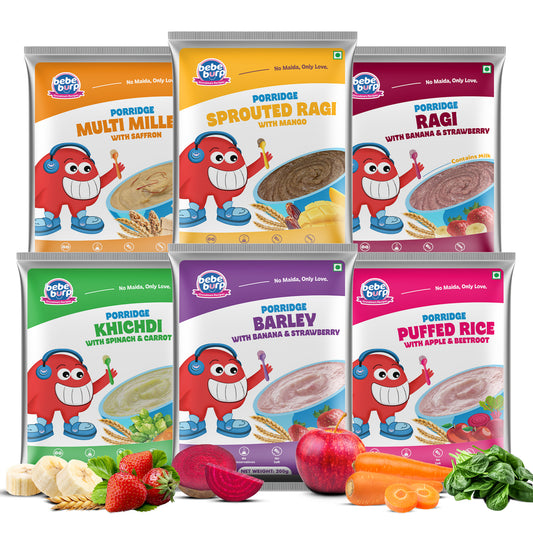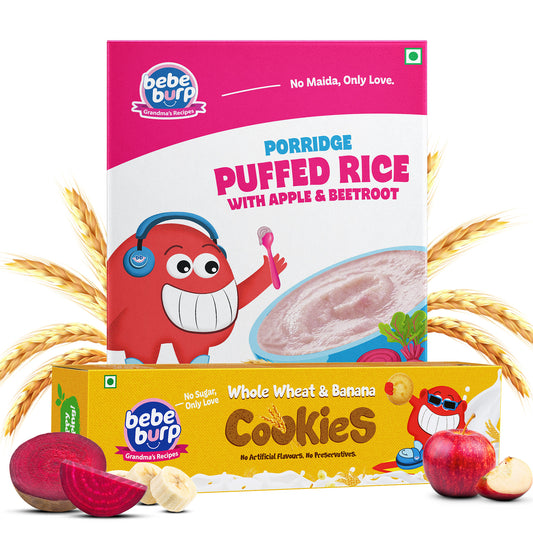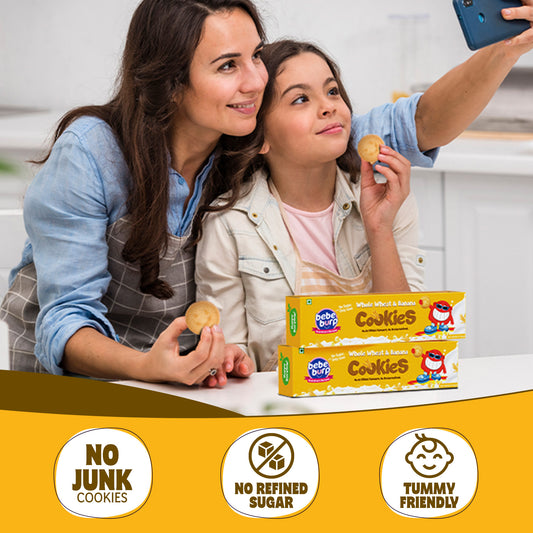The journey of introducing solid foods to your baby is a significant milestone in their early development. It marks a transition from a solely milk-based diet to a more diversified one, much needed for their growth and well-being. Beyond nutrition, this transition also helps babies learn to chew, swallow, and develop oral motor skills. Moreover, introducing a variety of foods at an early age can set the stage for healthy eating habits later in life. Now, when it comes to this first food, rice porridge, often referred to as rice baby cereal, has long been a popular choice here. It offers a gentle and easily digestible source of carbohydrates, which comes with energy for your baby's active growth. Additionally, rice is generally considered hypoallergenic, making it a safe choice for most infants. So mothers, let’s dive deeper into rice porridge as one of the first foods for babies.
Preparing Rice Porridge for Babies
Once you've determined that your baby is ready for solid foods and consulted with your paediatrician, it's time to dive into the art of preparing rice porridge that's not only nutritious but also delicious for your little one. Keep scrolling through to understand the hows!
Selecting the right type of rice is the foundation of a good rice porridge. Not all rice varieties are created equal when it comes to making the ideal porridge for your baby. Some rice types are better suited due to their texture and nutritional content. As you keep reading, we'll dive deeper into the differences between short-grain, long-grain, and glutinous rice, allowing you to make an informed choice for your baby's meals. Safe to say, proper rice preparation is essential to ensure the porridge has the right texture and is easily digestible for your baby. This includes rinsing the rice to remove excess starch, which can make the porridge overly sticky, and soaking it to soften the grains for smoother cooking. Understanding these techniques will help you master the art of rice preparation for your baby's meals.
Once you prepare the rice, it's time to cook it into a delightful porridge. Now, each method has its own advantages and may cater to different preferences or kitchen setups. Babies go through distinct stages of weaning, and their ability to handle different textures evolves as they grow. It's crucial to adapt the consistency of the rice porridge to match your baby's developmental stage. For infants just starting on solids, a smoother and thinner porridge is ideal to prevent choking hazards. As your baby progresses, you can gradually make the porridge thicker and chunkier to encourage chewing and improve oral motor skills.
Adding Flavors and Variety to Rice Porridge for Babies
While rice porridge is a fantastic base for your baby's meals, it doesn't have to be bland. You can make mealtime an exciting and enjoyable experience for your little one by incorporating fruits, vegetables, and mild seasonings to enhance the flavour profile of the porridge without overwhelming your baby's palate. By introducing variety early on, you can help your baby develop a diverse and adventurous taste for different foods. As you embark on the exciting journey of introducing rice porridge to your baby, it's essential to consider their individual needs and preferences. Here’s how you can do that.
- Start with Small Portions and Gradually Increase: Begin your baby's culinary journey with small, manageable portions of rice porridge. This allows them to get accustomed to the new texture and taste. Gradually increase the portion size as your baby becomes more comfortable with the porridge. Watch for signs of readiness for larger servings, like increased interest in food and the ability to sit up with support.
- Ensure a Smooth Texture for Early Stages of Weaning: In the initial stages, rice porridge should be smooth and easily digestible. You can achieve this by blending or mashing it thoroughly. A smoother texture reduces the risk of choking and makes it easier for your baby to swallow.
- Transition to Thicker and Chunkier Porridge: As your baby grows and develops their chewing abilities, you can gradually introduce thicker and chunkier rice porridge. This transition helps in developing your baby's oral motor skills and prepares them for a wider variety of foods.
- Encourage Self-Feeding: Encourage self-feeding by providing your baby with baby-friendly utensils and allowing them to explore the porridge independently. Be prepared for messes, as this is a crucial part of the learning process. It's all part of the fun!
Nutrition for Babies
Rice porridge is a source of essential nutrients like carbohydrates, which provide energy, and proteins necessary for growth and development. It also contains vitamins and minerals such as B vitamins, iron, and calcium. Iron is a critical nutrient for your baby's cognitive and physical development. To enhance iron absorption, pair rice porridge with foods rich in vitamin C. Consult with a paediatrician to ensure your baby is getting all the essential vitamins and minerals they need during this crucial stage. As your baby's palate expands, gradually introduce a variety of complementary foods, such as fruits, vegetables, and lean proteins. This diversity not only provides a wide range of nutrients but also helps your baby develop a preference for different flavours.
Allergies and Special Dietary Needs
When it comes to introducing allergenic ingredients in your baby's rice porridge, it's essential to tread carefully. Allergenic foods like dairy, eggs, nuts, and seafood can trigger adverse reactions in some infants. Start by introducing a small quantity of the allergenic ingredient into the rice porridge. For example, you can begin with a tiny amount of finely grated cheese or a trace of nut butter. After introducing the allergenic food, closely observe your baby for any signs of an adverse reaction. Symptoms may include skin issues like hives or eczema, digestive problems such as diarrhoea or vomiting, respiratory difficulties like wheezing, or general fussiness. Remember that allergic reactions can vary in severity. In case of any concerning symptoms, stop the introduction of the allergenic ingredient immediately and seek guidance from a healthcare professional. If your baby shows no signs of an allergic reaction, you can gradually increase the amount of the allergenic food over time while continuing to monitor their response. However, it's crucial to remain cautious and vigilant throughout the process.
Recognizing food allergies in your baby is a critical aspect of their health and safety. While introducing new foods, keep an eye out for any unusual symptoms or behaviours that might suggest an allergy. Common food allergy symptoms in infants may include:
- Skin reactions: Hives, redness, itching, or eczema.
- Respiratory issues: Wheezing, coughing, or nasal congestion.
- Digestive problems: Diarrhoea, vomiting, or abdominal pain.
- General discomfort: Irritability, fussiness, or changes in sleep patterns.
If you suspect that your baby is experiencing a food allergy, it's crucial to consult your paediatrician or an allergist promptly. They can conduct allergy testing, such as skin prick tests or blood tests, to confirm the diagnosis. Once a food allergy is confirmed, your healthcare provider will work with you to develop an appropriate management plan. This plan may include eliminating the allergenic food from your baby's diet and providing guidance on suitable alternative foods to ensure nutrition for babies. It's important to be proactive in managing food allergies to prevent potential severe reactions. Always carry any prescribed medications or epinephrine auto-injectors as recommended by your healthcare provider in case of an emergency.
Adjusting Rice Porridge for Babies with Special Dietary Needs
Some babies may have special dietary needs due to various factors, such as food intolerances, medical conditions, or cultural preferences. If your baby falls into this category, it's advisable to consult with a healthcare professional or paediatric dietitian. They can provide personalised guidance on modifying rice porridge to meet your baby's specific requirements. Modifications may involve using alternative grains like quinoa or millet if rice is not suitable, avoiding specific allergenic ingredients, or adjusting the texture and consistency of the porridge to accommodate your baby's unique needs. A healthcare professional can also offer recommendations on supplements or fortified foods to ensure your baby receives all the necessary nutrients for healthy growth and development. Remember that every baby is unique, and what works best for one may not be suitable for another. Seeking professional guidance ensures that your baby's nutritional needs are met while accommodating their special dietary needs.
Safety Tips and Precautions for Rice Porridge for Babies
- Store rice porridge in airtight containers in the refrigerator and consume it within a reasonable time frame.
- When reheating, ensure it's heated thoroughly to kill any potential bacteria.
- Remove any small, hard, or potentially choking hazards from the porridge, such as seeds or large chunks.
- Always supervise your baby while they eat to prevent choking incidents.
- Maintain excellent hygiene when preparing and serving rice porridge. Wash your hands and utensils thoroughly, and ensure a clean feeding environment.
- Avoid sharing utensils or taste-testing with the same spoon you use for your baby's food.
Introducing rice porridge to your baby is a beautiful journey filled with opportunities for growth and bonding. It's a time to celebrate your baby's milestones, and it sets the stage for a lifetime of healthy eating habits. Remember that as a parent, you play a crucial role in guiding your baby's nutritional journey, and your paediatrician is your trusted partner in ensuring your baby's health and well-being. One of the most delightful aspects of introducing your baby to new foods is witnessing their curiosity and delight as they explore different tastes, textures, and colours. The early experiences your baby has with food can significantly influence health eating for babies in the long run. By offering a diverse and nutritious diet, you can help them develop a taste for a wide range of foods. Encourage self-feeding and a positive mealtime environment to foster a healthy relationship with food from the start. Embrace this exciting phase and savour every moment as your little one explores the world of flavours and textures, one spoonful at a time.
FAQs
- When should I start introducing rice porridge to my baby?
It's generally recommended to begin introducing solid foods, including rice porridge, around six months of age. However, individual readiness cues, such as the ability to sit up independently and show interest in food, should also guide your decision. Always consult with your paediatrician for personalised advice.
- What type of rice is best for making rice porridge for babies?
Short-grain rice varieties, such as Arborio or japonica, are often preferred for making rice porridge due to their higher starch content, which results in a creamy texture. These rice types are gentle on your baby's tummy and ideal for early weaning.
- How do I ensure the rice porridge is the right consistency for my baby's age?
Adjusting the consistency of rice porridge is crucial as your baby progresses through different stages of weaning. For early stages, make it smoother and thinner to prevent choking hazards. Gradually thicken the porridge as your baby becomes more experienced with solids.
- What nutrients are there in rice porridge for baby's growth?
Rice porridge for babies offers essential nutrients such as carbohydrates for energy, fibre for digestion, proteins for muscle development, and various vitamins and minerals (e.g., B vitamins, magnesium, phosphorus) for overall growth and cognitive development.
- Why is iron important in my baby's diet, and how can I ensure they get enough?
Iron is vital for your baby's growth, and rice porridge alone may not provide sufficient iron. It's crucial to introduce iron-rich complementary foods such as meat purees for babies, fortified baby cereals, or legumes alongside rice porridge to meet your baby's iron needs and ensure health eating for babies.
- How can I introduce a variety of foods to my baby alongside rice porridge?
Gradually introduce different fruits, vegetables, lean proteins, and whole grains as complementary foods. Start with one new food at a time to monitor your baby's reaction. Mixing these foods with rice baby porridge can create a balanced diet.
- What should I do if my baby has a food allergy?
If you suspect a food allergy, stop giving that particular food to your baby and consult your paediatrician. They can help identify the allergen and provide guidance on managing allergies in your baby's diet.
- Can I introduce allergenic ingredients like nuts or eggs into rice porridge for babies?
While rice is generally hypoallergenic, it's advisable to introduce allergenic ingredients separately to monitor your baby's reaction. Consult your paediatrician for guidance on safely incorporating these ingredients into your baby's diet.
- What are common choking hazards to be aware of during mealtime?
Choking hazards can include small, hard foods, large chunks, or foods with tough skins. Ensure that foods are appropriately sized and prepared to reduce the risk of choking. Always supervise your baby during meals.
- How can I maintain a clean and safe kitchen environment while preparing rice porridge for my baby?
Practise good hygiene by washing your hands and sanitising utensils and cooking surfaces. Keep raw and cooked foods separate, and store prepared rice baby porridge safely to prevent contamination.








